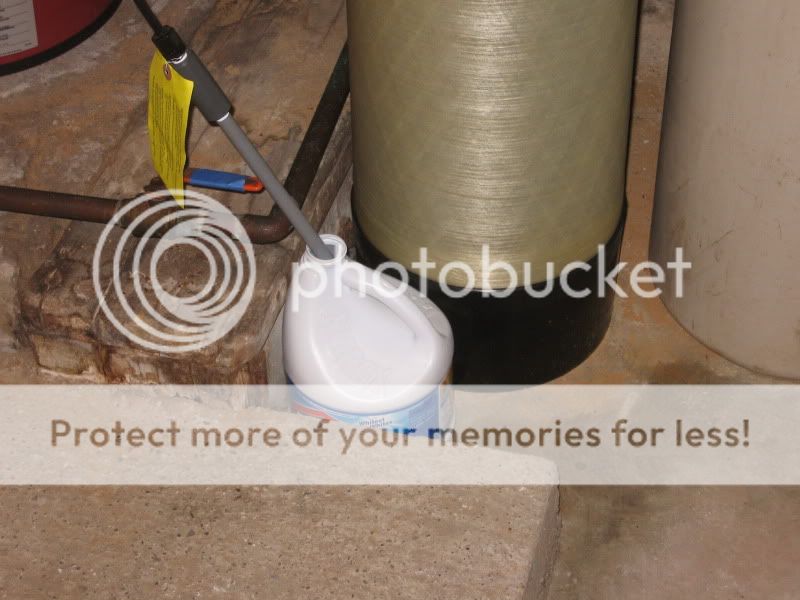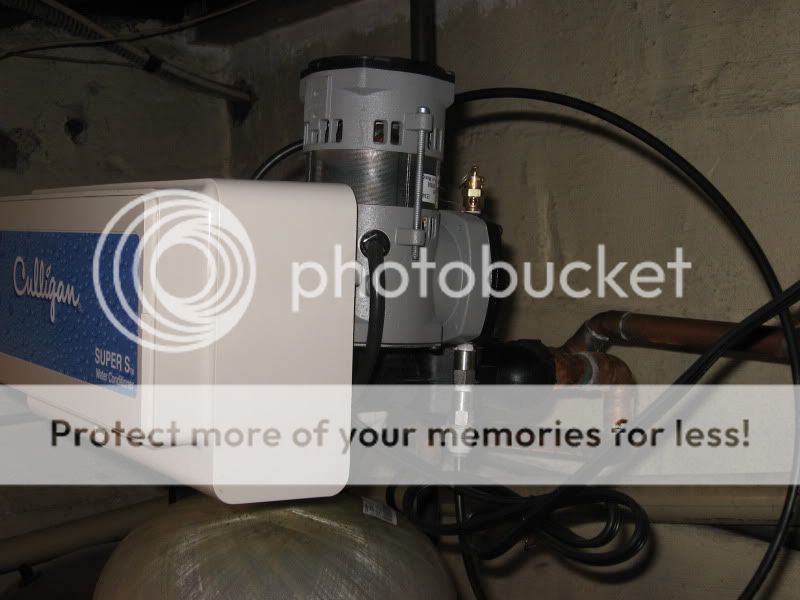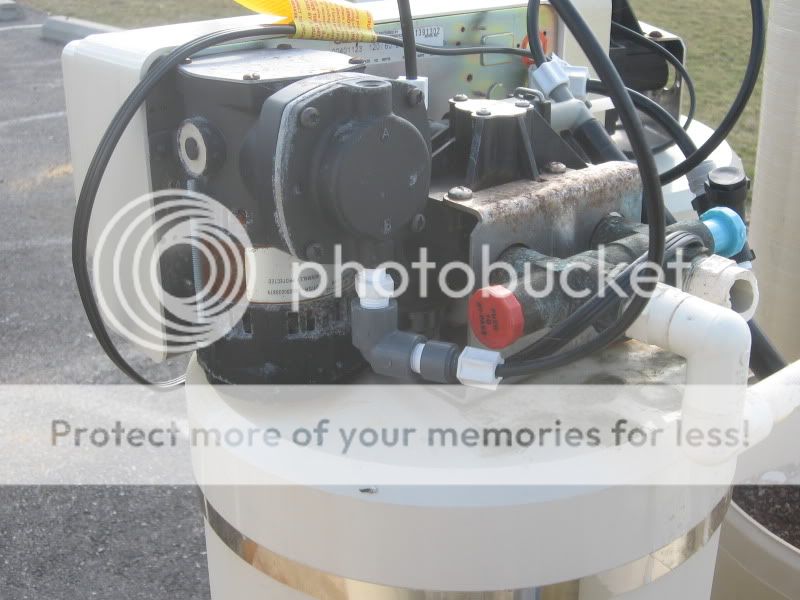You are using an out of date browser. It may not display this or other websites correctly.
You should upgrade or use an alternative browser.
You should upgrade or use an alternative browser.
salty water from conditioner
- Thread starter Gary23
- Start date
Users who are viewing this thread
Total: 2 (members: 0, guests: 2)
big dripper
New Member
Here is Culligan's Super S system with pump.
It sounds like your's is a homemade job. Saturating the carbon with large volumes of strong bleach often enough with shorten the life of the carbon fairly quickly.


It sounds like your's is a homemade job. Saturating the carbon with large volumes of strong bleach often enough with shorten the life of the carbon fairly quickly.


Last edited:
Sponsor
Paid Advertisement
They really like that little pump on their systems, it is on this one and there is the iron buster that they use the that same pump... One has to make sure that no water gets to the pump or it is out of the game, and spendy to rebuild.
big dripper
New Member
Like this that 'frooze up' due to moisture. Culligan said it wasn't repairable at the cost of replacing it.


Gary Slusser
That's all folks!
- Messages
- 6,921
- Reaction score
- 22
- Points
- 38
- Location
- Wherever I park the motorhome.
- Website
- www.qualitywaterassociates.com
The filter is regenerated with the chlorinated water out of the brine tank during the slow rinse/brine draw cycle position; the same as a softener.... here's info on that part of the system: the filter is upstream from my softener. It's a 3 cu ft resin tank with a Fleck controller on top and a water-filled tank attached to that Fleck. The setup looks just a water softener, with carbon in the resin tank and water from the brine tank that's used for backwash cycles instead of regen cycles. I was told to add a bottle of bleach to water tank weekly to shock that filter (which is what I meant by sanitizing earlier).
I have never heard of using carbon that way but, Pyrolox had been used like that for many years except the gallon of bleach was added every 3-4 weeks depending on how much iron, manganese and/or H2S was in the water and how much water was used. I sold many of them back in the '80s into the early '90s.
I can't imagine the average residential well pump successfully backwashing 3.0 cuft of Pyrolox. Pyrolox is very heavy an difficult to successfully backwash. Are you absolutely positively without any doubt that you have carbon in the filter? Pyrolox is black like carbon.
How sure are you that you were to add the gallon of bleach each week? That is way too much chlorine and way too frequently for any type of carbon. My Pyrolox filters only sucked 3-4" of chlorinated water off the top of the water in the salt tank and the tank had water in it up to about 11-13" from the top. So compared to once a week, the solution strength was much weaker.
The filter is regenerated with the chlorinated water out of the brine tank during the slow rinse/brine draw cycle position; the same as a softener.
I have never heard of using carbon that way but, Pyrolox had been used like that for many years except the gallon of bleach was added every 3-4 weeks depending on how much iron, manganese and/or H2S was in the water and how much water was used. I sold many of them back in the '80s into the early '90s.
I can't imagine the average residential well pump successfully backwashing 3.0 cuft of Pyrolox. Pyrolox is very heavy an difficult to successfully backwash. Are you absolutely positively without any doubt that you have carbon in the filter? Pyrolox is black like carbon.
How sure are you that you were to add the gallon of bleach each week? That is way too much chlorine and way too frequently for any type of carbon. My Pyrolox filters only sucked 3-4" of chlorinated water off the top of the water in the salt tank and the tank had water in it up to about 11-13" from the top. So compared to once a week, the solution strength was much weaker.
Based purely on the word of the designer/installer, there's carbon in there. And oops, I looked at my notes and I was originally toldto add 1 gallon bleach per month, not week. I don't think I've exceeded that rate. If anything, I did it less than once per month. The weekly instruction came recently, only for me to do for about a month. Attached picture shows this side of the system. Blue tank in back is pressure tank. That feeds into carbon filter in foreground with Fleck controller - cover. That filter is 12" diameter x 50" high. The white tube snaking around that goes to the black water tank. Culligan system is in back right of the picture. I'll also attach a picture of inside water tank. Yellow gunk on bottom is powder, I stirred it up and it re-sedimented after an hour or so.


So the yellow color at the bottom of the tank, Iron or the chlorine that you are using?
If there is any iron in the water it would be better for the carbon to be after the softener so that the carbon only has to deal with the smell and not the smell and iron. Carbon could care less as to what is in the water for removal.. Iron will load up the carbon faster than the smell..
I see that the carbon unit with the Fleck 2510 is a meter set up, or that it will go into a regen after X number of gallons and if you have 4 people in the house and close to 250 gallons per day and that meter only goes to 2100 gallons that is going to be about 8-10 days ,, give or take ..
If the tank that has the carbon is 12x52 then there is 2 cubic feet of carbon in the tank and not 3.
You could strip that Fleck down to a flat cap filter valve with a 12 day wheel so that every 6 days the unit backwashes and when the smell comes back even with backwashing every day it would be time to change out the carbon bed.
I my self would have carbon After a Softener and not before.
If there is any iron in the water it would be better for the carbon to be after the softener so that the carbon only has to deal with the smell and not the smell and iron. Carbon could care less as to what is in the water for removal.. Iron will load up the carbon faster than the smell..
I see that the carbon unit with the Fleck 2510 is a meter set up, or that it will go into a regen after X number of gallons and if you have 4 people in the house and close to 250 gallons per day and that meter only goes to 2100 gallons that is going to be about 8-10 days ,, give or take ..
If the tank that has the carbon is 12x52 then there is 2 cubic feet of carbon in the tank and not 3.
You could strip that Fleck down to a flat cap filter valve with a 12 day wheel so that every 6 days the unit backwashes and when the smell comes back even with backwashing every day it would be time to change out the carbon bed.
I my self would have carbon After a Softener and not before.
Last edited:
big dripper
New Member
Chlorine, being a powerful oxidizer, is most likely finding minerals in the water and causing precipitation. This is common in many solution tanks that operate likes yours.
Gary Slusser
That's all folks!
- Messages
- 6,921
- Reaction score
- 22
- Points
- 38
- Location
- Wherever I park the motorhome.
- Website
- www.qualitywaterassociates.com
Not following the schedule will ruin the filter's media. With carbon, more chlorine by adding it more frequently will also. So now the media needs replacing again.Based purely on the word of the designer/installer, there's carbon in there. And oops, I looked at my notes and I was originally toldto add 1 gallon bleach per month, not week. I don't think I've exceeded that rate. If anything, I did it less than once per month. The weekly instruction came recently, only for me to do for about a month.
You have a metered control valve on a filter that requires timely regeneration to prevent the media from fouling, not on gallons used.Attached picture shows this side of the system. Blue tank in back is pressure tank. That feeds into carbon filter in foreground with Fleck controller - cover. That filter is 12" diameter x 50" high. The white tube snaking around that goes to the black water tank. Culligan system is in back right of the picture. I'll also attach a picture of inside water tank. Yellow gunk on bottom is powder, I stirred it up and it re-sedimented after an hour or so.
Changing that control to a flat cap filter version is not the right way to go, it would be more expensive than buying a 12 day time clock model and selling your "softener" control.
Everything is in in the proper order of installation but you have carbon instead of an oxidizing mineral.
IMO that is wrong because carbon will not remove ferrous/soluble iron or manganese if any of either is present in your raw water. But, those things will use the dissolved oxygen in your water and carbon to convert (oxidize) some of each in the carbon which then loads up the carbon because backwashing can't get the sediment that oxidation causes out of the carbon bed.
So... the filter is basically removing nothing but sediment and H2S gas. The only benefit of the chlorine is bacterial control in the carbon bed and that is highly questionable but will ruin the carbon in a short period of time IMO.
The yellow in the chlorination (salt) tank is probably iron due to the use of raw water in the refill position and the chlorine oxidizing it in the brine tank. As long as the sediment in the brine tank doesn't get deep enough (2"+) to be sucked out during the brine draw position, it doesn't harm anything because that water goes to drain, not into your plumbing. But you can clean out the tank if you want to as long as you know the yellow is simply going to form again.
Your softener looks to be about a 1/2 or 3/4 cuft model. That is awful small.
On both media tanks there should be a label, the model number of the tank will tell you the size of the tanks; I.E. Model 1252 is a 12" x 52" tank which is a 2.0 cuft. IMO you can't get 2.5 cuft or more in that tank.
Your filter tank has a tank adapter in it, the gray part that the control valve is screwed into, and that means your tank has a 4" opening, reduced to the industry standard 2.5" x 8 threads/inch for the control valve to be screwed into. That is a bit abnormal for a 12" dia tank, usually there's a standard tank hole until you get to 14" dia tanks but it's not a problem for you and makes it easier for you to pour the old mineral out when needed. But you don't have 3.0 cuft of media in that tank.
The Taylor pool test kit is not great for potable water--alkalinity and hardness don't necessarily correlate. Total hardness is testing for the content of calcium and magnesium. The Taylor calcium kit tests only for calcium. Your total hardness is almost certainly higher than the result for calcium only.
So to get accurate results you need a total hardness test kit or have the water tested by someone who can give you that figure. You should also have tests done for iron and manganese.
To properly program your softener you need the above mentioned test results. You will also need to know the quantity of resin in your softener, the size of the brine line flow control (BLFC) and have access to a manual for the control valve on your softener. Of course you could have Culligan do all these things for you.
Your problems with the softener could be caused by low water pressure--restriction in the water supply. I would recommend you resolve the water pressure issue before spending time and effort on the softener.
Water pressure & flow rate seems like an important thing for this problem. My pressure tank is set to shut off at 60 PSI. I drew 2.25 gallons of water, then pump kicked on for 16 seconds. So that's a flowrate of 8.4 GPM.
No other news. System still shows salt leakage into drinking water and sulfur smell. I will submit a water sample to a test lab to get a good understanding of water chemistry. From reading comments from experts so far, my treatment system may not be the best design for this situation. So I'll be looking at cost to repair/rebed the current equipment vs getting new gear put in.
Is the water level in the brine tank going down between regens?
The salt tast in the water, is it just the morning after or all the time?
Dunno on the first question. You mean water level in the brine well or in the tank? Just in the AM on 2nd. The first few gallons from a tap will be salty on some mornings. I think our regen is set for every other day, so that probably lines up there.
Sounds like the brine rinse is not long enough or the rapid rinse is not long enough.
There are two other items that can do it, low water pressure while in the brine draw part of the cycle, also a partly pluged injector and or screen on the culligan.
There are two other items that can do it, low water pressure while in the brine draw part of the cycle, also a partly pluged injector and or screen on the culligan.
Similar threads
- Replies
- 0
- Views
- 169
- Replies
- 3
- Views
- 505
- Replies
- 2
- Views
- 308
- Replies
- 9
- Views
- 1K
- Replies
- 0
- Views
- 141
